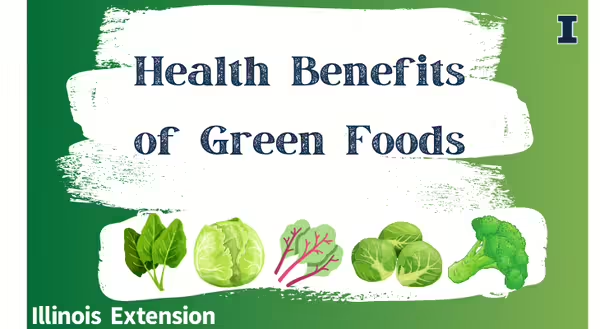
Function of Phytonutrients in Plants
- Colored pigments in plants are produced to protect them from pathogens, predators, and climate conditions.
- They attract pollinators
- Contribute to the plants’ sensory characteristics, color, and nutritional value.
- The chlorophyll (green pigment) in plants absorbs light so plants can make energy (food). This process of photosynthesis also produces oxygen for the planet.
Dietary Sources of Chlorophyll
- Leafy greens- spinach, cress, chervil, lettuce, arugula, celery, Swiss chard
- High in nutrients that protect heart health and reduce blood pressure; particularly dietary nitrates.
- Cruciferous vegetables- broccoli, Brussels sprouts, kale, cabbage, bok choy
- Associated with reduced cardiovascular (CVD) mortality and atherosclerosis (hardening of the arteries) due to its antioxidant and anti-inflammatory properties.
Green foods are abundant in nutrients associated with heart health including, vitamin K, magnesium, potassium, dietary nitrates, and folates. A meta-analysis found that consuming green vegetables every day could reduce CVD risk by 15.8%.
Chlorophyll has shown anti-oxidant activity and can help treat inflammation and related diseases.
Eating green foods has anti-inflammatory benefits- inflammation can happen in the body for a number of reasons. Perhaps it’s due to a response to stimuli (allergies), injuries, or pathogens. Inflammation results in redness, pain, function losses, and also a large number of pro-inflammatory markers in the body. It’s important to treat inflammation since it is linked to many chronic diseases.
Eating green foods has antioxidant benefits- free radicals are a product of the body’s natural metabolism. However, an accumulation can be toxic and lead to the acceleration of the aging process and chronic conditions such as neurodegenerative and cardiovascular disorders, cancer, atherosclerosis, and ulcerative colitis.
Adding More Phytonutrients to your Diet
Ensure you’re getting a good daily dose of heart-protective nutrients by eating more of the green foods listed above. It is well known that increasing fruit and vegetable intake can help prevent the onset of chronic diseases. Remember to improve your nutrient diversity by “eating a rainbow” of colors and choosing foods that are nutrient-dense like fruits and vegetables every day!
Interested in red, purple, and blue foods? Learn more about the health benefits of anthocyanins- Eat red, blue, and purple foods for better health: University of Illinois Extension
Interested in bright orange and yellow foods? Learn about the health benefits of carotenoid-rich foods- Eat carotenoid-rich foods for better health: University of Illinois Extension
Interested in the white subgroup? Learn more about the health benefits of anthoxanthin-rich foods- Eat white fruits and vegetables for better health: University of Illinois Extension
Sources:
Deanna M. Minich, "A Review of the Science of Colorful, Plant-Based Food and Practical Strategies for “Eating the Rainbow”", Journal of Nutrition and Metabolism, vol. 2019, Article ID 2125070, 19 pages, 2019. https://doi.org/10.1155/2019/2125070
R. L. Pollock, “The effect of green leafy and cruciferous vegetable intake on the incidence of cardiovascular disease: a meta-analysis,” JRSM Cardiovascular Disease, vol. 5, Article ID 2048004016661435, 2016.
Subramoniam, Appian et al. “Chlorophyll revisited: anti-inflammatory activities of chlorophyll a and inhibition of expression of TNF-α gene by the same.” Inflammation vol. 35,3 (2012): 959-66. doi:10.1007/s10753-011-9399-0
X. Zhang, X.-O. Shu, Y.-B. Xiang et al., “Cruciferous vegetable consumption is associated with a reduced risk of total and cardiovascular disease mortality,” The American Journal of Clinical Nutrition, vol. 94, no. 1, pp. 240–246, 2011.